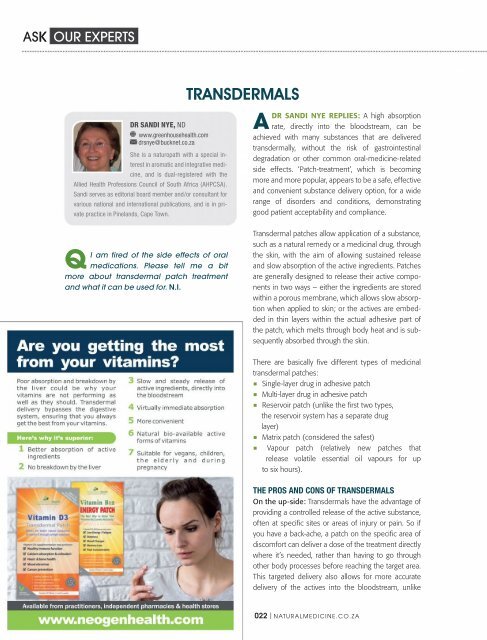Natural_Medicine_Magazine_Issue_145_July_2017
Create successful ePaper yourself
Turn your PDF publications into a flip-book with our unique Google optimized e-Paper software.
ASK OUR EXPERTS<br />
DR SANDI NYE, ND<br />
www.greenhousehealth.com<br />
drsnye@bucknet.co.za<br />
She is a naturopath with a special interest<br />
in aromatic and integrative medicine,<br />
and is dual-registered with the<br />
Allied Health Professions Council of South Africa (AHPCSA).<br />
Sandi serves as editorial board member and/or consultant for<br />
various national and international publications, and is in private<br />
practice in Pinelands, Cape Town.<br />
TRANSDERMALS<br />
ADR SANDI NYE REPLIES: A high absorption<br />
rate, directly into the bloodstream, can be<br />
achieved with many substances that are delivered<br />
transdermally, without the risk of gastrointestinal<br />
degradation or other common oral-medicine-related<br />
side effects. ‘Patch-treatment’, which is becoming<br />
more and more popular, appears to be a safe, effective<br />
and convenient substance delivery option, for a wide<br />
range of disorders and conditions, demonstrating<br />
good patient acceptability and compliance.<br />
Q<br />
I am tired of the side effects of oral<br />
medications. Please tell me a bit<br />
more about transdermal patch treatment<br />
and what it can be used for. N.I.<br />
Transdermal patches allow application of a substance,<br />
such as a natural remedy or a medicinal drug, through<br />
the skin, with the aim of allowing sustained release<br />
and slow absorption of the active ingredients. Patches<br />
are generally designed to release their active components<br />
in two ways – either the ingredients are stored<br />
within a porous membrane, which allows slow absorption<br />
when applied to skin; or the actives are embedded<br />
in thin layers within the actual adhesive part of<br />
the patch, which melts through body heat and is subsequently<br />
absorbed through the skin.<br />
There are basically fi ve different types of medicinal<br />
transdermal patches:<br />
Single-layer drug in adhesive patch<br />
Multi-layer drug in adhesive patch<br />
Reservoir patch (unlike the fi rst two types,<br />
the reservoir system has a separate drug<br />
layer)<br />
Matrix patch (considered the safest)<br />
Vapour patch (relatively new patches that<br />
release volatile essential oil vapours for up<br />
to six hours).<br />
THE PROS AND CONS OF TRANSDERMALS<br />
On the up-side: Transdermals have the advantage of<br />
providing a controlled release of the active substance,<br />
often at specifi c sites or areas of injury or pain. So if<br />
you have a back-ache, a patch on the specifi c area of<br />
discomfort can deliver a dose of the treatment directly<br />
where it’s needed, rather than having to go through<br />
other body processes before reaching the target area.<br />
This targeted delivery also allows for more accurate<br />
delivery of the actives into the bloodstream, unlike<br />
022 | NATURALMEDICINE.CO.ZA

















